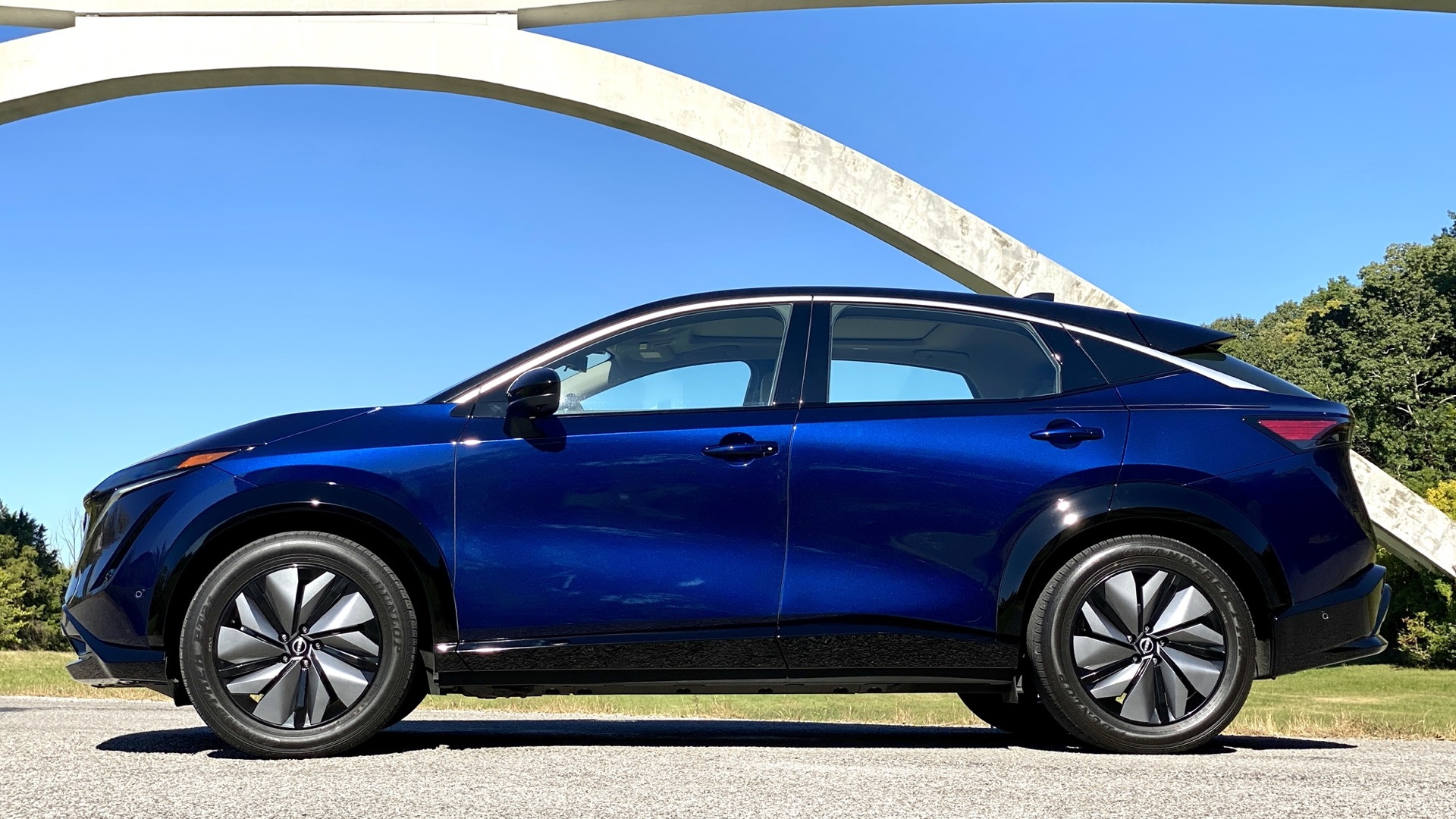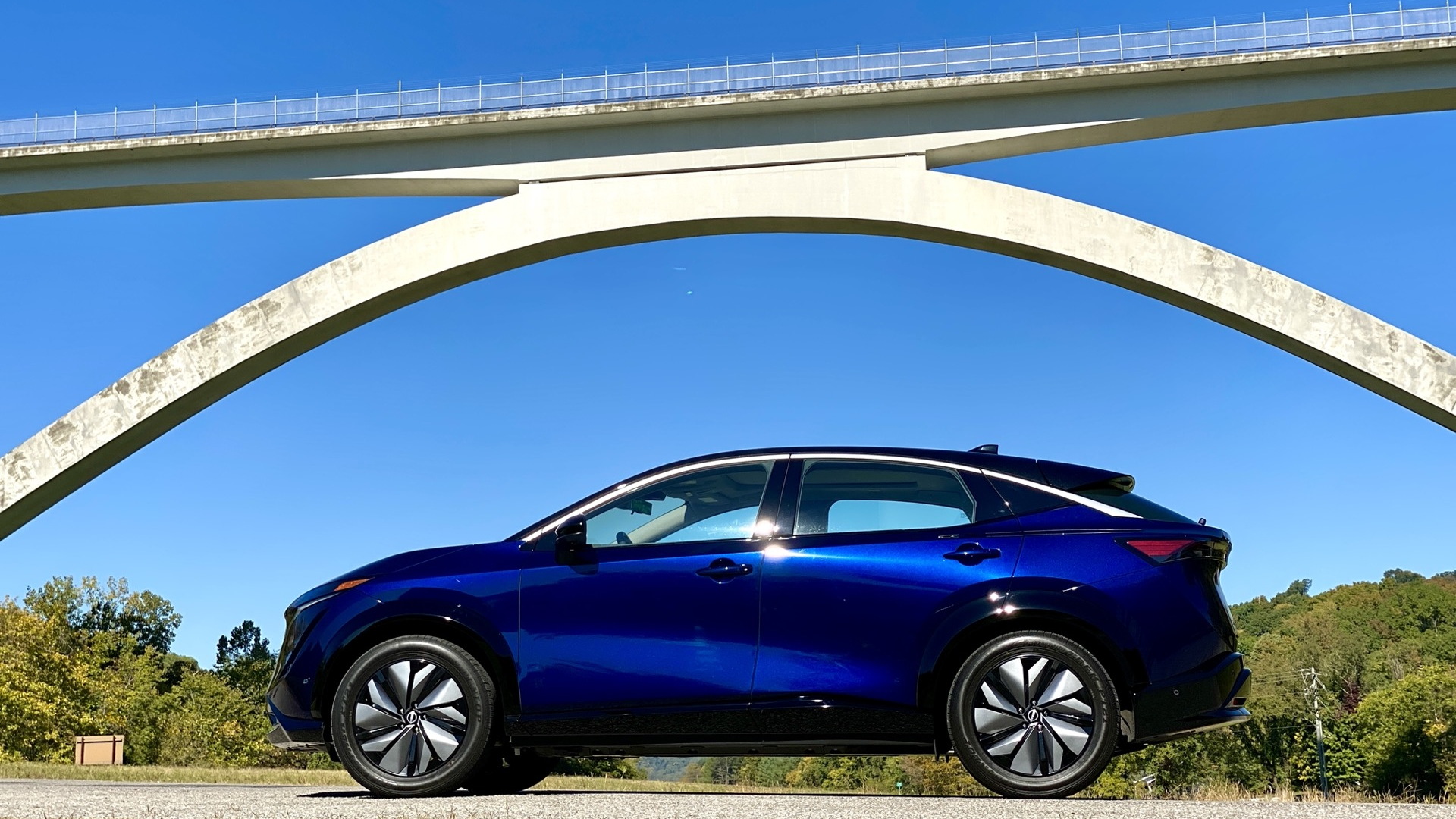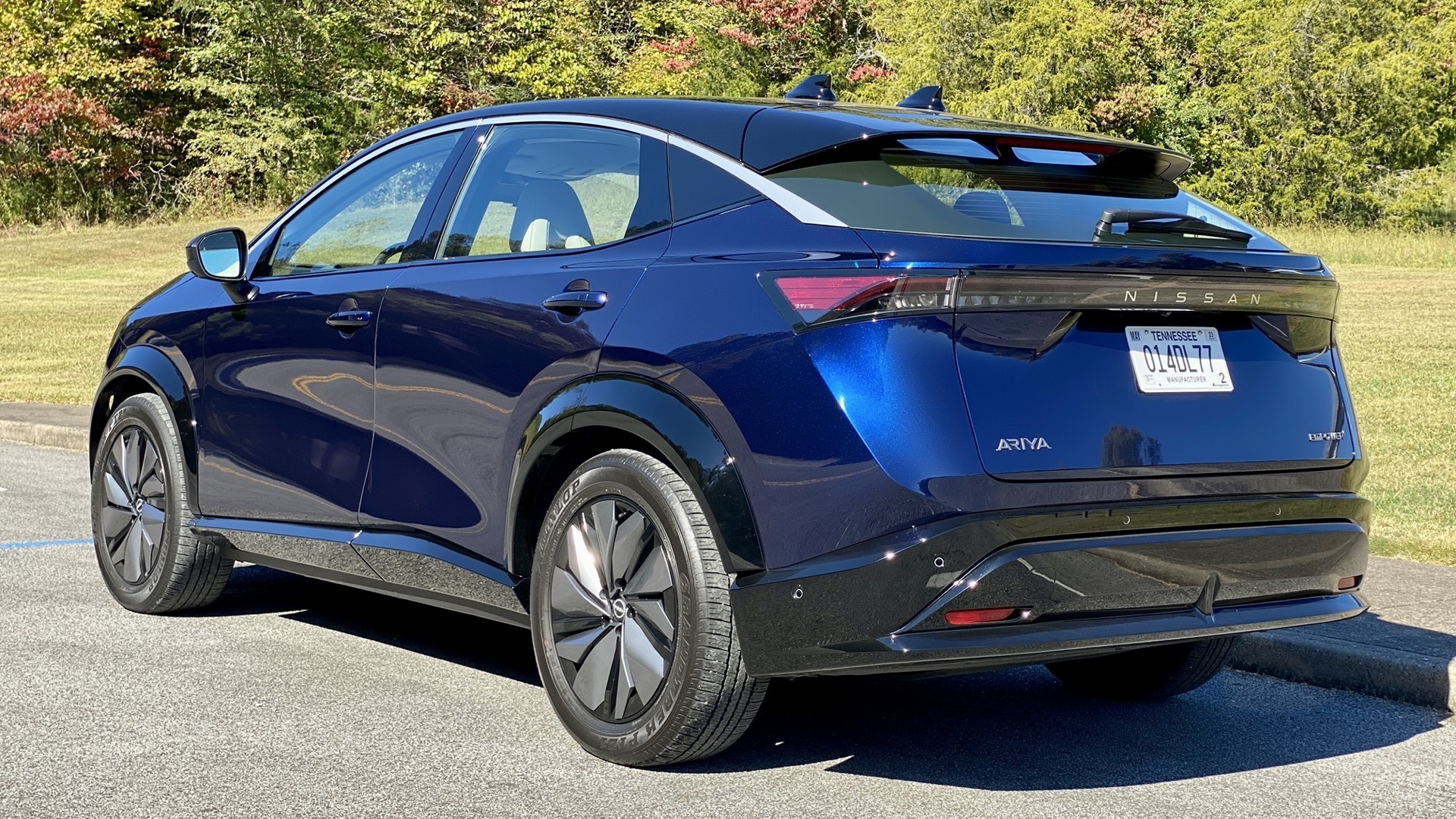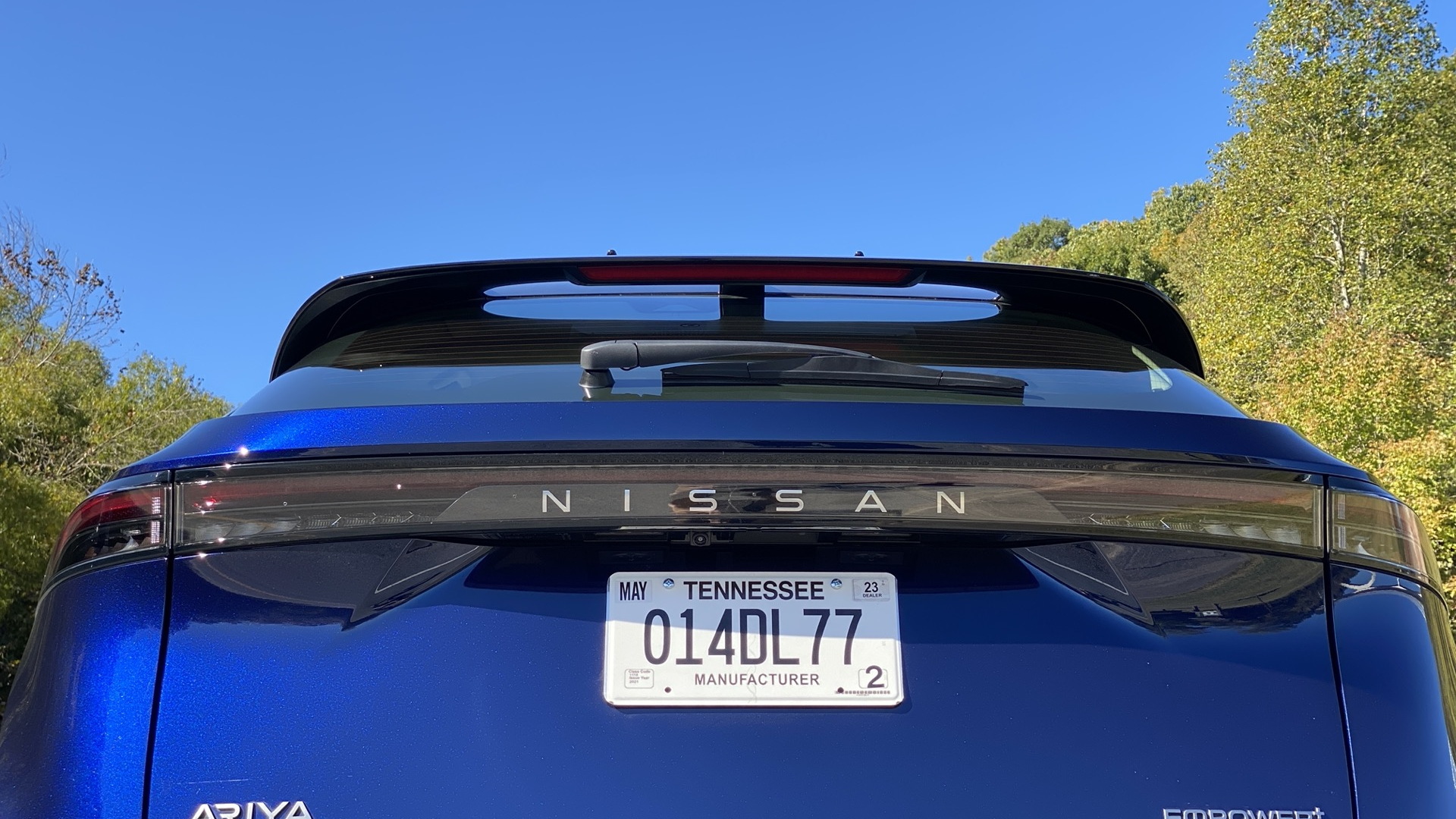The 2023 Nissan Ariya not only represents the best new ground-up Nissan in years, it also reorients a brand that has seemed adrift since its erstwhile leader, Carlos Ghosn, ran afoul of the law. Yet the electric crossover is not without its problems, most notably in the recurring delays keeping it from the starting line.
Timing might not be everything, but it is definitely something. And Nissan knows this, as the first automaker to launch an electric vehicle for the masses way back in late 2010 with the Nissan Leaf. It seems like another era since then, but the past year has had an even greater effect on the Ariya. Scheduled for mid-2021 and derailed due to Covid-related chip shortages and production problems, the Ariya finally arrives at dealerships now, much later than the competition.
“The chip shortages have caused a lot of disruption,” Aditya Jairaj, Nissan’s director of electric vehicles marketing, told Green Car Reports. “We also want customers to have the right car.”
The single-motor front-wheel-drive model is the right car for now; it’s the only car. The dual-motor variant arrives early next year, but that gap was always part of the plan, Jairaj said.
So many electric cars have launched since the Ariya’s original launch date, including the Hyundai Ioniq 5, Kia EV 6, and the 2023 Volkswagen ID.4 Standard with a small battery and single motor that costs less than $40,000—the original target price of the Ariya. Now the 2023 Nissan Ariya starts at $44,485 and crests $60,000. The forthcoming Ariya e-4orce all-wheel-drive variant will add about $4,000 across the lineup.
Yet Nissan is not dissuaded.
“We feel that Ariya is hitting at just the right time,” said Brian Brockman, Nissan VP of communications.
Maybe so. Not only is the Ariya the brand’s most impressive new vehicle in years, it optimizes the interior space in such a way as to raise the bar for electric crossovers at this price.
Sized like the Nissan Rogue compact crossover but with an extended wheelbase like the Nissan Murano mid-size crossover, the Ariya has a wide open interior. It has a more rounded bulb of a roof, and a more upright stance than sportier electric crossovers such as the Kia EV6 and Ford Mustang Mach-E.
2023 Nissan Ariya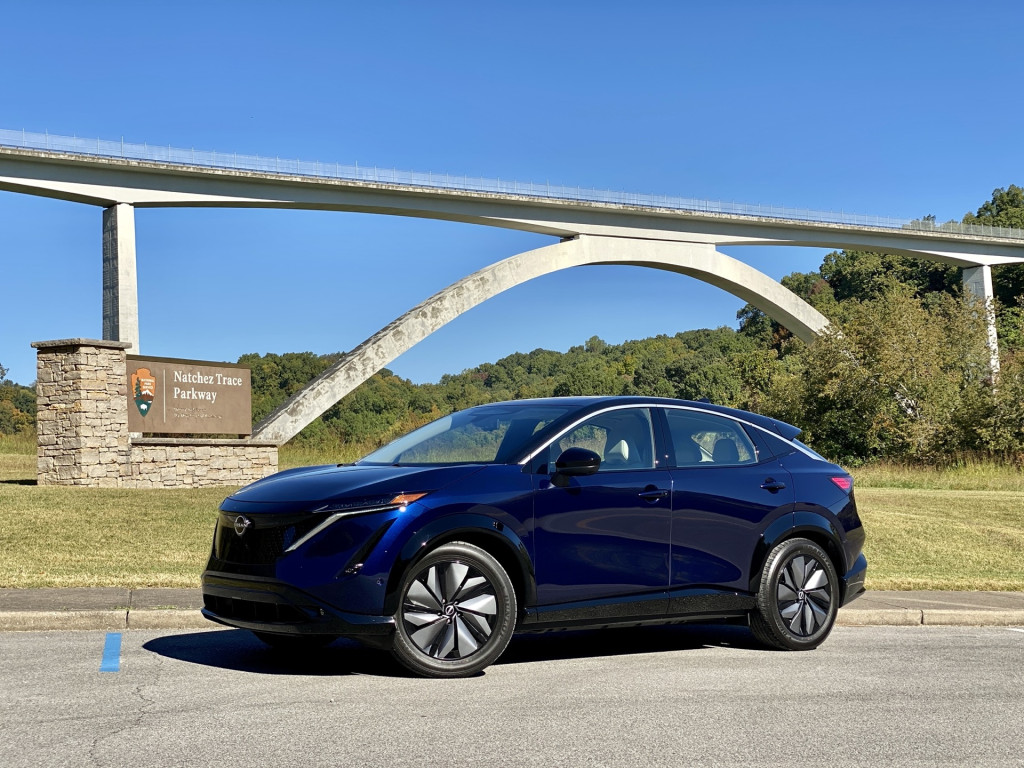
Tuned for comfort
Sport is not the Ariya’s forte.
I tested the top Premier trim with the larger 87-kwh battery pack at a price of $55,985, including destination. Nissan encouraged me to drive on the lovely winding roads of the Natchez Trace Parkway, beyond Nissan’s manufacturing plants in Smyrna, Tennessee, where the Nissan Leaf is made. The Ariya is imported from Japan, for now. Nissan’s plant in Canton, Miss., will make two new EVs in 2025—one Nissan, one Infiniti—but Nissan hasn’t disclosed what might be beyond those first two.
An externally excited synchronous motor rated at 178 kw powers the front wheels for an output of 238 hp and 221 lb-ft of torque. With a 0-60 mph time of 7.2 seconds, it’s quicker and more responsive than the 4-cylinder cars in Nissan’s lineup. But it’s slower than electric rivals, and lacks the surge of power that makes EVs fun to drive. That might be by design, as Nissan intended to ease the transition to electric by making the driving experience familiar with that of an internal combustion car.
The softness applies to the suspension as well as the throttle and steering. The front struts and multilink rear suspension feel springy, as if tuned to handle more weight, perhaps for the AWD version. The weight distribution slightly favors the front, but it tends to pitch forward and nose dive in more spirited driving. It seems to ride higher than other electric crossovers so the body lean in winding roads is more pronounced. The steering is similarly soft and removed from the road, as if it doesn’t expect or encourage more assertive inputs.
It’s exceptionally quiet thanks in part to laminated side glass and the noise absorption compounds on the stock Dunlop Sport Maxx tires. There’s some mild but expected road noise above 70 mph from the standard 19-inch wheels with aero covers.
2023 Nissan Ariya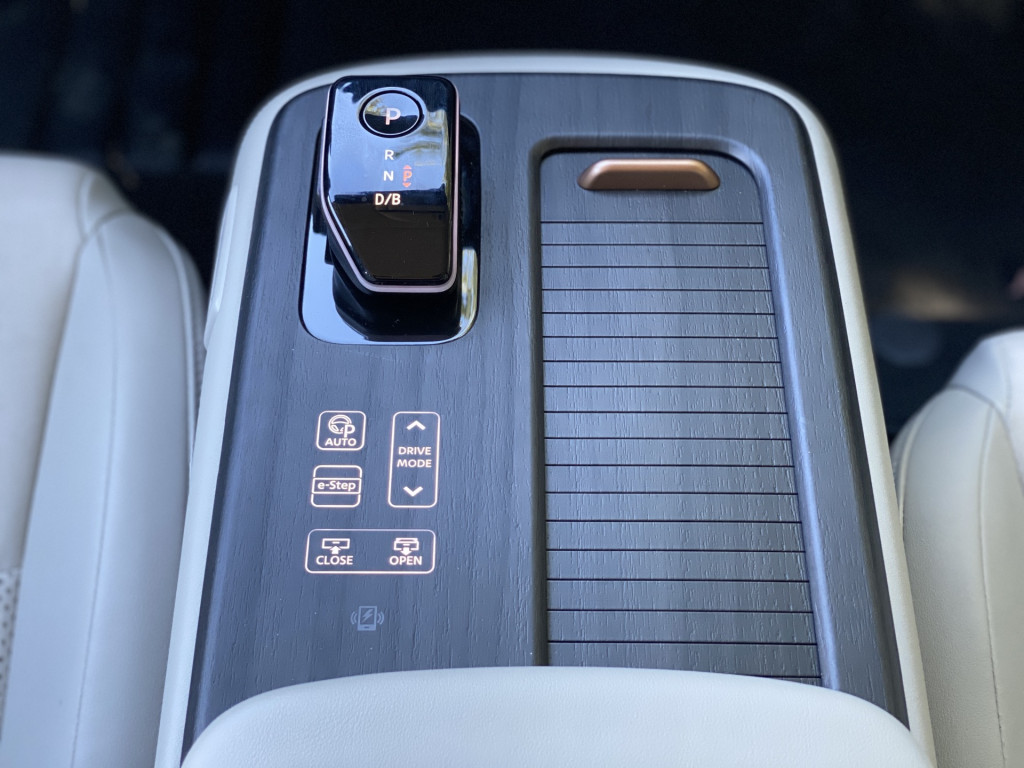
The other sacrifice to the familiarity of a gas car is the limited regenerative brake setting. Similar to the Nissan Leaf, an e-Pedal Step button offers regenerative braking, but unlike the Leaf, it doesn’t go down to a full stop. Instead, letting off the accelerator gradually brings the car into a creep mode, like in a car with an internal combustion engine and automatic transmission. Oddly, the B setting in the console-mounted gear shifter seemed to have more significant regen braking. There’s no one-pedal driving, and no auto hold, and no real EV advantage here.
It’s a disappointment to simulate gas car characteristics, especially in contrast to the clean-sheet rethink of the interior.
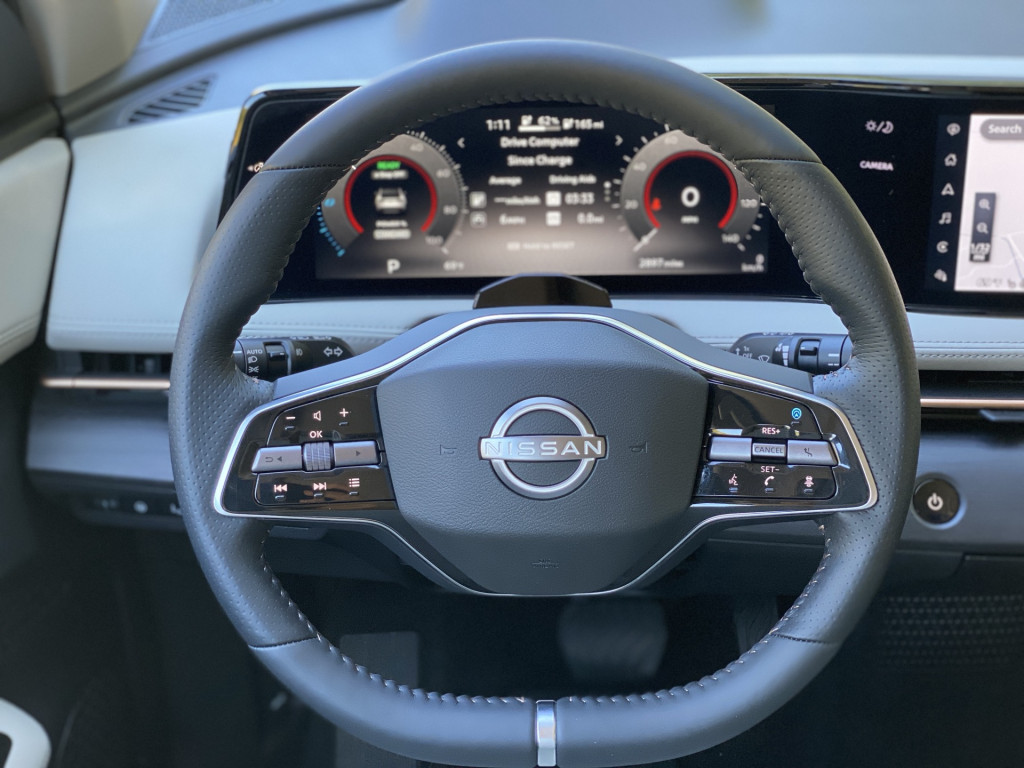
2023 Nissan Ariya
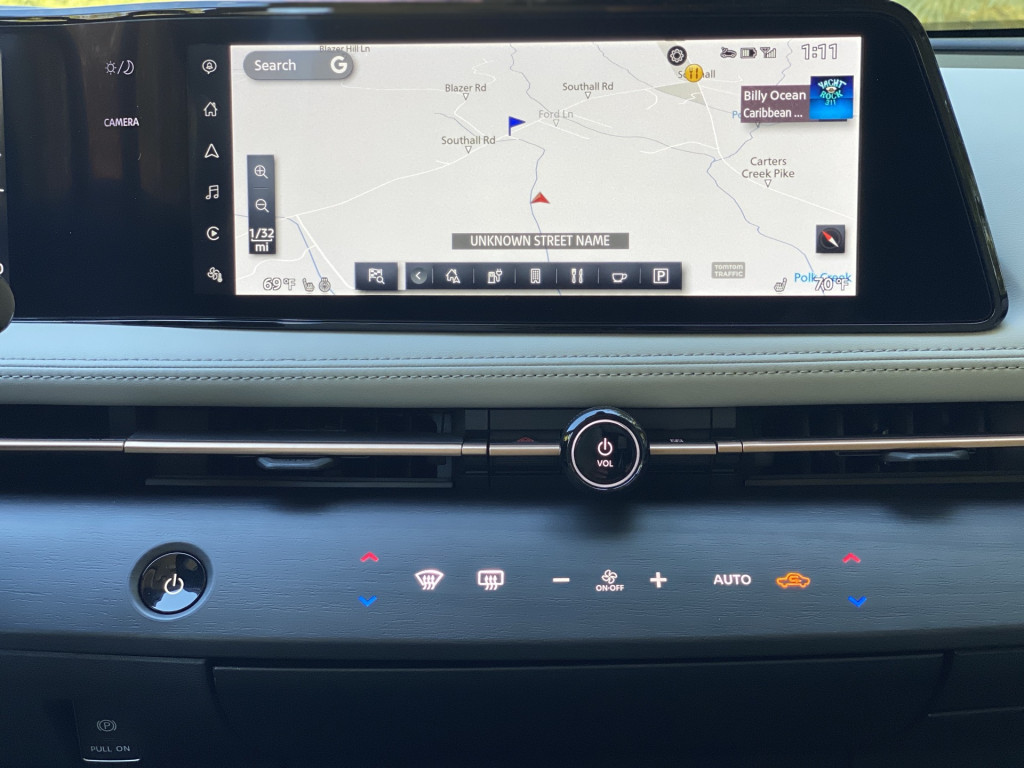
2023 Nissan Ariya
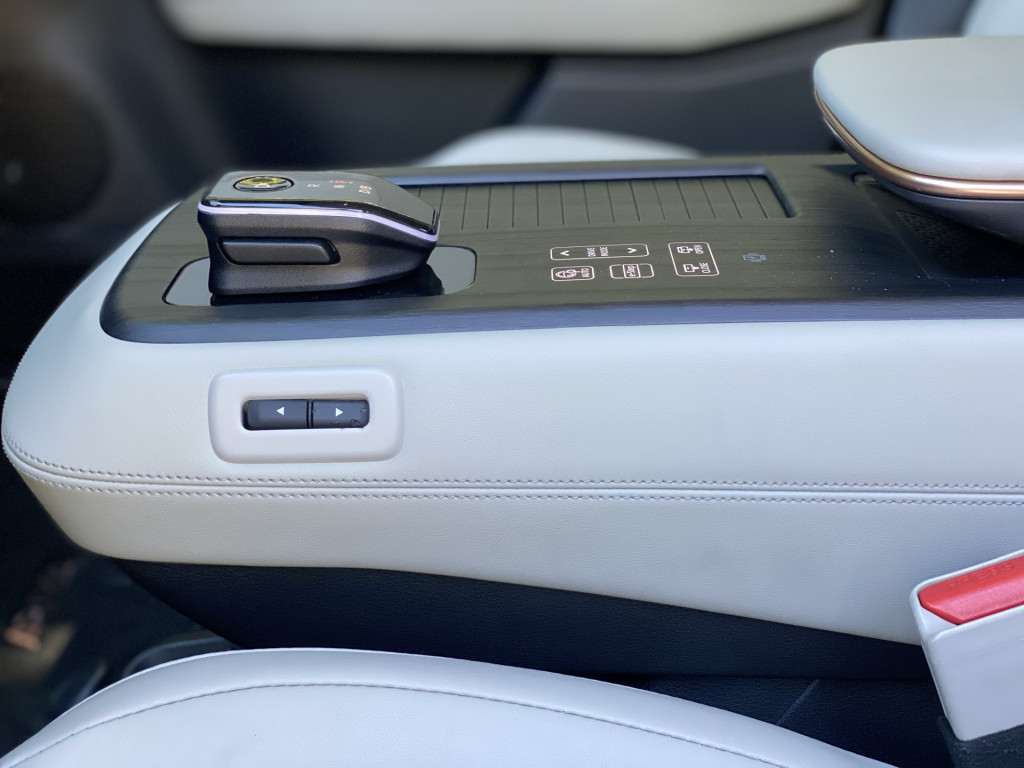
2023 Nissan Ariya

2023 Nissan Ariya
Comfort is king
The cabin invites occupants in with a soft synthetic leather upper dash underscored by a thin horizon of vents bisected by metallic trim. A standard 12.3-inch digital instrument cluster snakes into the standard 12.3-inch touchscreen under one piece of glass, going from concave to convex, and the Ariya showcases Nissan’s new infotainment interface.
2023 Nissan Ariya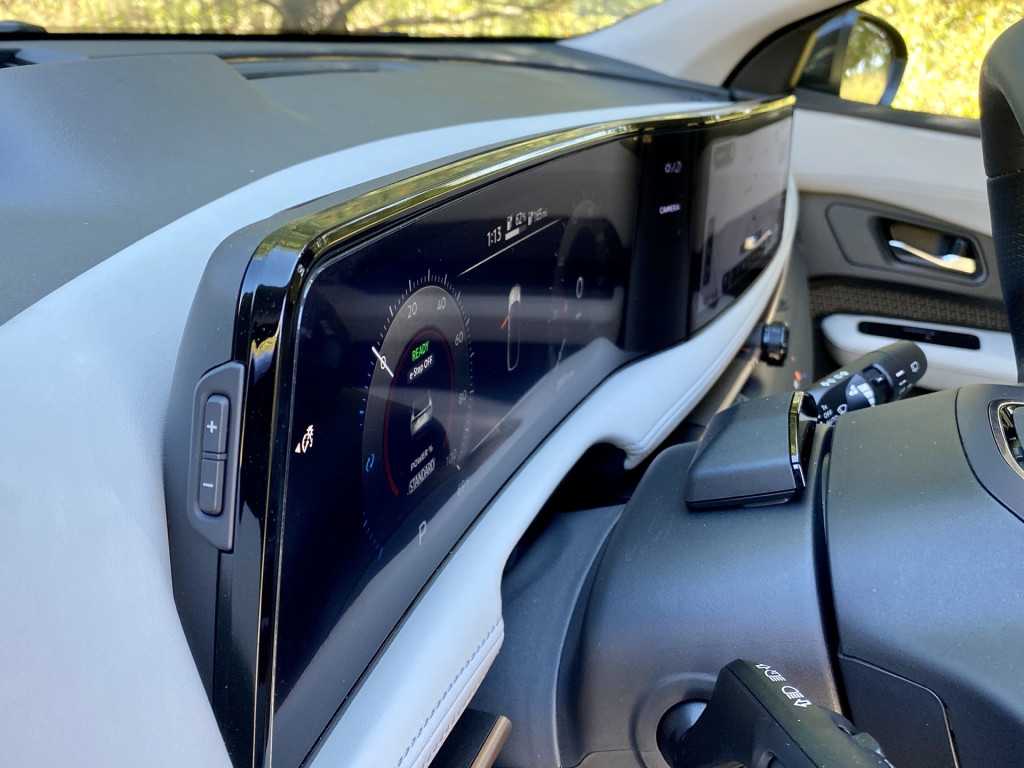
Its horizontal plane is styled like the Hyundai Ioniq 5 but with menu buttons on the left side, and hot navigation buttons on the bottom of the map display. The Apple CarPlay display takes up the full screen, but I’d appreciate a split screen that lets you toggle between it and the native infotainment keys. But most of that info—map display, efficiency meter—is accessible in the instrument cluster. It’s easier to use, and much better integrated, than the system in the Mustang Mach-E, and so much more user friendly than that of the ID.4. A volume knob sticks out of the center of the vent panel, but it’s not centered with the touchscreen display, which may vex the most OCD among us.
Underneath the vents is a synthetic open-pore wood panel stretching from end to end that looks and feels like the real thing. Haptic climate controls are baked into the wood panel with as much fidelity to the touch as traditional buttons. It looks great, with the illuminated icons seemingly hovering over the faux wood instead of blemishing it. Of all the touch-sensitive panels on the market now, it’s the only one that hasn’t made me wish for dials and buttons.
2023 Nissan Ariya
The flat-bottomed steering wheel ubiquitous in Nissan’s lineup lends the Ariya roominess. The floor is wide open, like the bench seat days of old but with the comfort and variability of power front buckets.
The open floor plan includes a center console that power slides up to 6.0 inches. It’s more refined than the manual sliding console in the Ioniq 5. The wood-like trim graces the console, including on the cupholder cover. The only thing that feels familiar to Nissan is the gear shifter on the console, which is underwritten by drive mode and e-Step buttons. The console also houses a smart wireless smartphone charging tray, which angles up underneath the armrest. I slid it in without looking and my i-Phone always caught the charge. The only drawback is it’s easy to forget under the armrest.
The sliding console also makes room in the back, or brings USB ports closer to rear-seat occupants. Four 6-foot-2 adults could stack front to back in comfort, but head room might prompt the tallest passenger, such as the 6-foot-6 Editor of Green Car Reports, to have to slouch a bit. The 37.0 inches of rear leg room feels like an understatement, though.
2023 Nissan Ariya
Fold down the 60/40-split rear seats, and cargo space expands from 22.8 cubic feet to 59.7 cubic feet. All but the Venture+ models have a tiered cargo floor with clever storage compartments.
It feels like the roomiest electric crossover in its cohort, even with a panoramic sunroof bisected by a bar instead of the fixed glass roofs spanning the ID.4 and Mustang Mach-E.
Next-gen ProPilot Assist 2.0
The Nissan Ariya also shows off the next-generation of ProPilot Assist 2.0, Nissan's limited hands-free driving system. Designed like GM’s Super Cruise system but not as sophisticated, it enables hands-free driving on more than 200,000 miles of restricted access highways in North America.
A driver monitor mounted to the top of the steering column ensures the driver keeps their eyes on the road. If not, a series of escalating alerts will activate, including brake pulsing, until the system shuts off and it initiates an emergency stop. The instrument cluster icons change color based on readiness, so the white steering wheel icon turns green when the road conditions have been met and the system is ready. A push of the steering wheel button turns the icon blue, indicating it’s active. At night, the ambient lighting ringing the doors and dash also reflects the semi-autonomous status.
2023 Nissan Ariya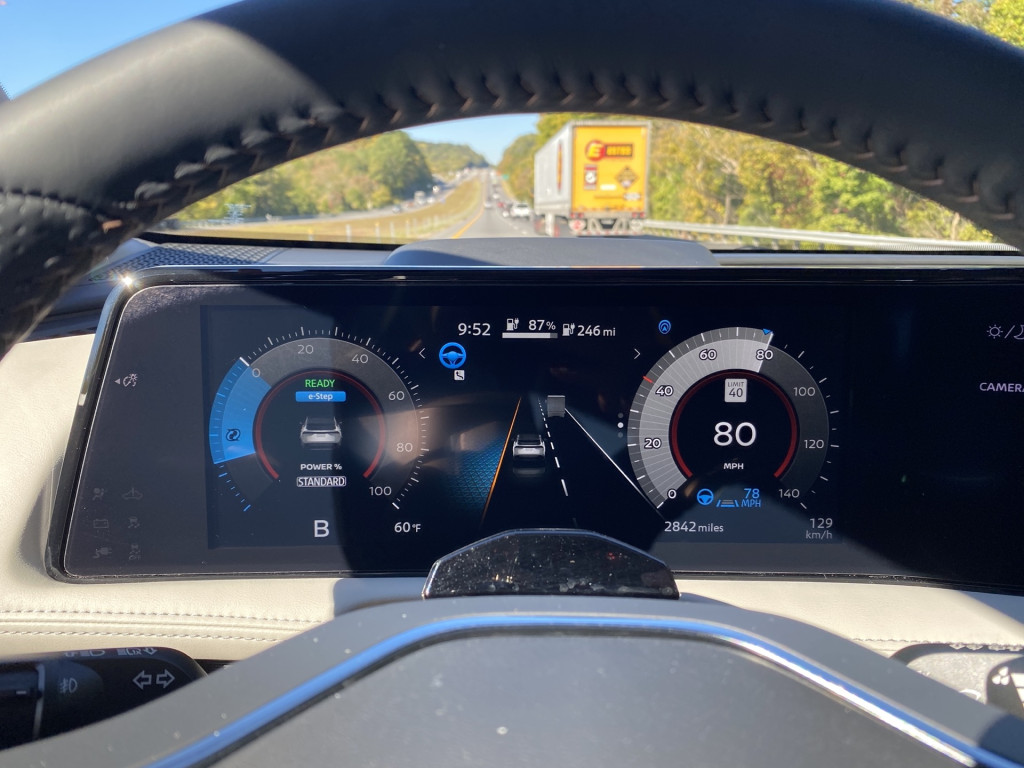
In our brief testing outside of Nashville, it worked well with good lane positioning and awareness of other vehicles, though it was more conservative than Super Cruise. It has an automatic lane change function that activates in one of three ways: through the navigation setting; based on system suggestions; and by a manual blinker. In any scenario the driver has to have hands on the wheel, rendering it kind of useless. Still, hands-free driving from Nashville to Chicago with minimal driver interaction is possible and regular updates promise to make it better. Every time the Ariya is turned on, the HD map gets updated by Ushr.
Single-motor efficiency
The base Ariya with the 63-kwh battery pack has an estimated range of 216 miles, while the pared-down Venture+ trim with the 87-kwh battery pack has a 304-mile range. Most Ariyas have a rating of 289 miles. The EPA numbers translate to a good efficiency rating of 3.0 miles per kwh, but I can’t corroborate that based on the hilly drive route and heavy throttle use during my day of driving.
2023 Nissan Ariya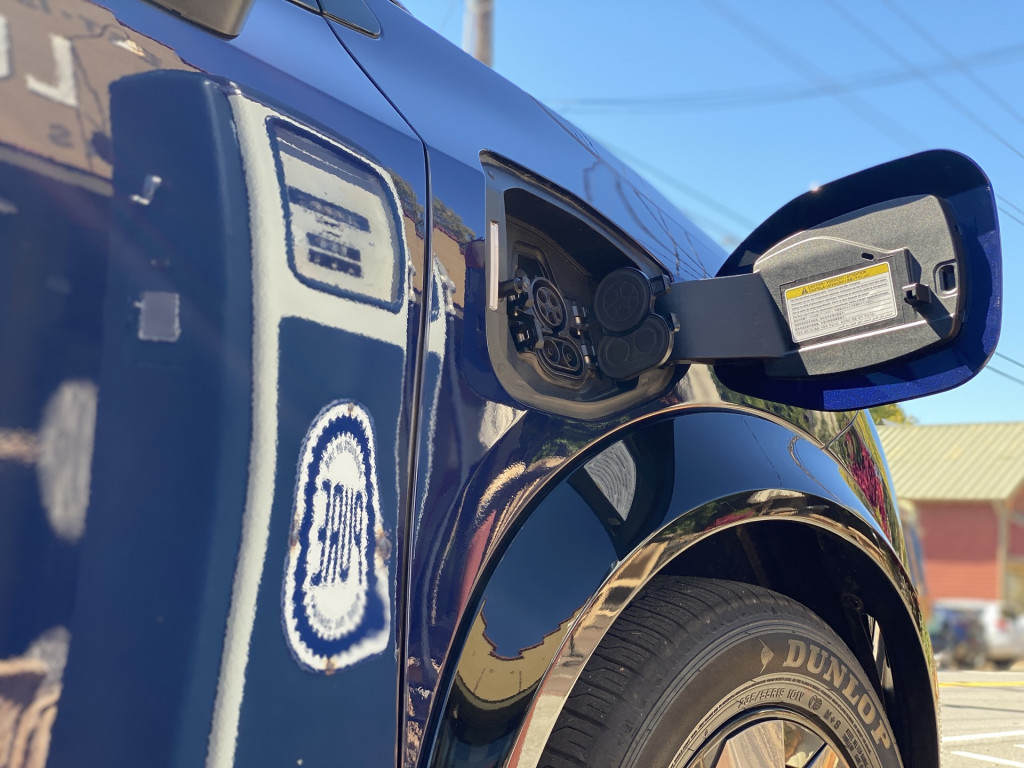
It DC fast-charges at a peak rate of 130 kw, and it is on the CCS protocol, cementing Nissan's shift away from CHAdeMO, which is still the Leaf's charging protocol. Charging the battery from 10% to 80% at that rate takes about 40 minutes. Nissan provides a 7.2-kw onboard charger to charge at home on a 240-volt circuit at up to 30 amps, enabling a full charge in 14 hours. Those times are longer than the competition, but not by enough to be a deal breaker.
There’s a lot to like about the Ariya. With dual-motor all-wheel-drive variants around the corner, it should only get better as improved performance complements the comfy character of Nissan’s best vehicle.
CORRECTION: A sentence in the above piece has been changed to reflect that the Ariya’s hands-free driving data comes from Ushr, not TomTom as originally reported.
